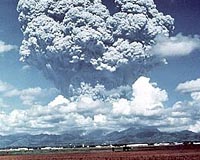| . |  |
. |
Washington (AFP) Nov 2, 2009 The snows capping Mount Kilimanjaro, Africa's tallest peak, are shrinking rapidly and could vanish altogether in 20 years, most likely due to global warming, a US study published Monday said. The ice sheet that capped Kilimanjaro in 1912 was 85 percent smaller by 2007, and since 2000 the existing ice sheet has shrunk by 26 percent, the paleoclimatologists said. The findings point to the rise in global temperatures as the most likely cause of the ice loss. Changes in cloudiness and precipitation may have also played a smaller, less important role, especially in recent decades, they added. "This is the first time researchers have calculated the volume of ice lost from the mountain's ice fields," said study co-author Lonnie Thompson, professor of earth sciences at Ohio State University, "If you look at the percentage of volume lost since 2000 versus the percentage of area lost as the ice fields shrink, the numbers are very close," he said in the study published in the journal Proceedings of the National Academy of Sciences. While the yearly loss of the mountain glaciers is most apparent from the retreat of their margins, Thompson said an equally troubling effect is the thinning of the ice fields from the surface. The summits of both the Northern and Southern Ice Fields atop Kilimanjaro have thinned by 1.9 meters (6.2 feet) and 5.1 meters (16.7 feet) respectively. The smaller Furtwangler Glacier, which was melting and water-saturated in 2000 when it was drilled, has thinned as much as 50 percent between 2000 and 2009, the study said. "It has lost half of its thickness," Thompson said. "In the future, there will be a year when Furtwangler is present and by the next year, it will have disappeared. The whole thing will be gone." The scientists said they found no evidence of sustained melting anywhere else in the ice core samples they extracted, which date back 11,700 years. They said their findings show that current climate conditions over Mount Kilimanjaro are unique over the last 11 millennia. Share This Article With Planet Earth
Related Links Beyond the Ice Age
 Volcanoes Set The Stage For An Ice Age
Volcanoes Set The Stage For An Ice AgeColumbus OH (SPX) Oct 29, 2009 Researchers here have discovered the pivotal role that volcanoes played in a deadly ice age 450 million years ago. Perhaps ironically, these volcanoes first caused global warming - by releasing massive amounts of carbon dioxide into the atmosphere. When they stopped erupting, Earth's climate was thrown off balance, and the ice age began. The discovery underscores the importance of carbon ... read more |
|
| The content herein, unless otherwise known to be public domain, are Copyright 1995-2009 - SpaceDaily. AFP and UPI Wire Stories are copyright Agence France-Presse and United Press International. ESA Portal Reports are copyright European Space Agency. All NASA sourced material is public domain. Additional copyrights may apply in whole or part to other bona fide parties. Advertising does not imply endorsement,agreement or approval of any opinions, statements or information provided by SpaceDaily on any Web page published or hosted by SpaceDaily. Privacy Statement |